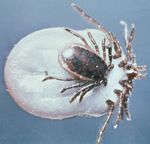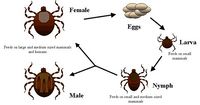Difference between revisions of "Tick Life Cycle"
Jump to navigation
Jump to search
| Line 22: | Line 22: | ||
| − | [[Category:Ticks]] | + | [[Category:Ticks|A]] |
[[Category:To_Do_-_NickJ]] | [[Category:To_Do_-_NickJ]] | ||
Revision as of 13:49, 22 July 2010
| This article is still under construction. |
Overview
Ticks are temporary ectoparasites meaning that they only spend a short period of their lives on the host species, the rest of the time is spent free living in the environment. Ticks life cycles consist of 3 stages; larva, nymph and adult. Between each life stage the tick must take at least one blood meal in order to develop to the next stage or to produce eggs. Hard ticks take a single large blood meal at each life stage where as soft ticks feed in smaller meals more frequently and can do so on many hosts.
Hard ticks
Hard ticks can be classified by the number of host species they parasitise during their life cycle.
One-host ticks
- These ticks will feed at each stage and develop on the same host. This group includes the genus Boophillus.
Two-host ticks
- In these species both the larvae and nymphs feed and develop on the same host. The nymphs will leave the host once they have taken a meal and develop into adults which will feed on a new host. The genus Hyalomma is an example of two host ticks.
Three-host ticks
- Each stage of the three host ticks life cycle will feed on a different host species. In general the size of the host will increase with each feed as the size of the tick increases. The Ixodes genus of ticks are three host feeders.

